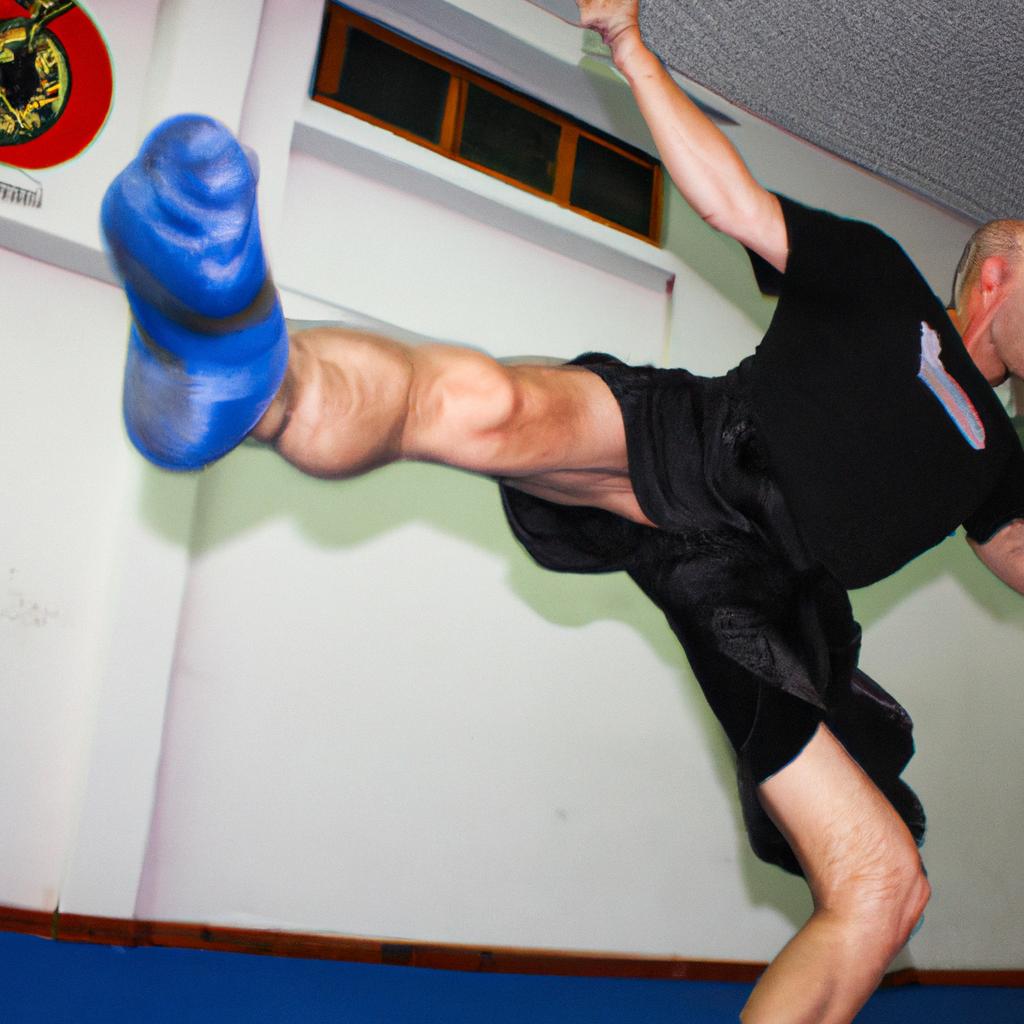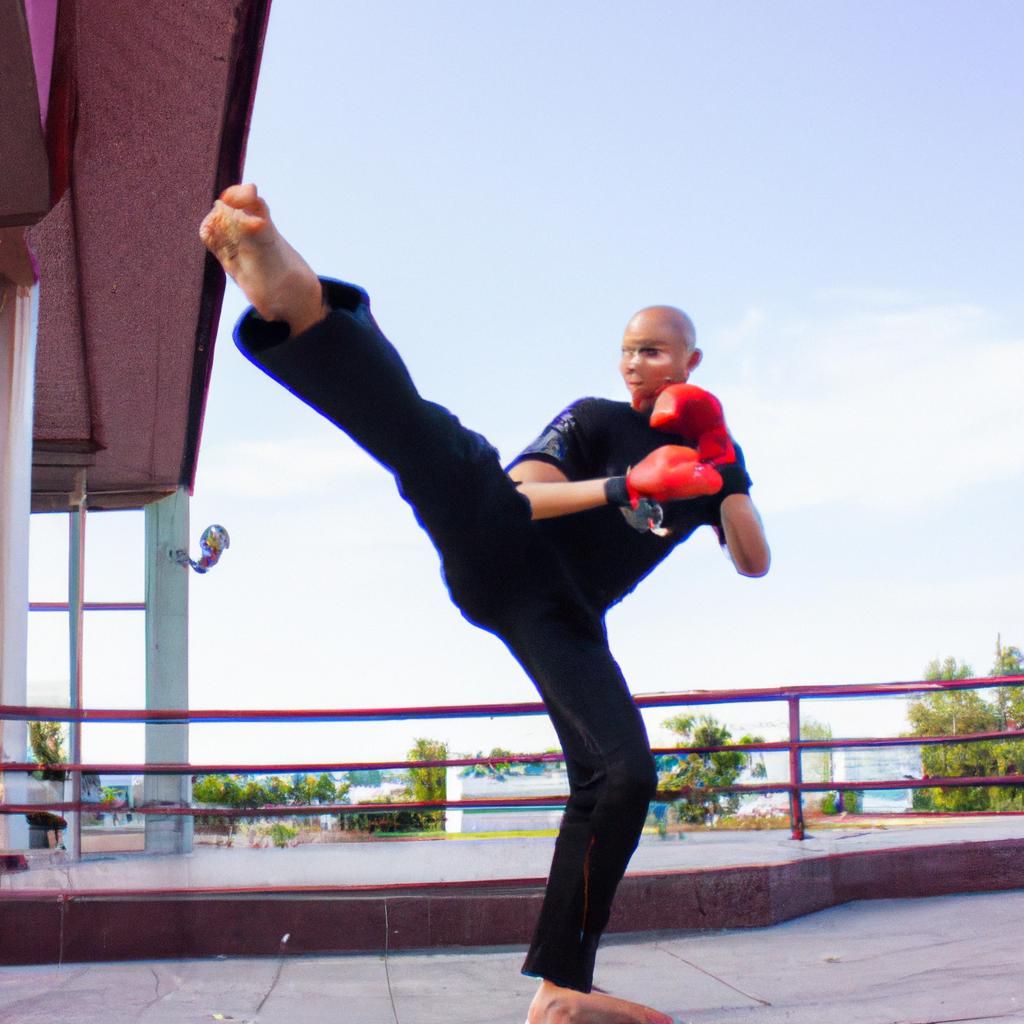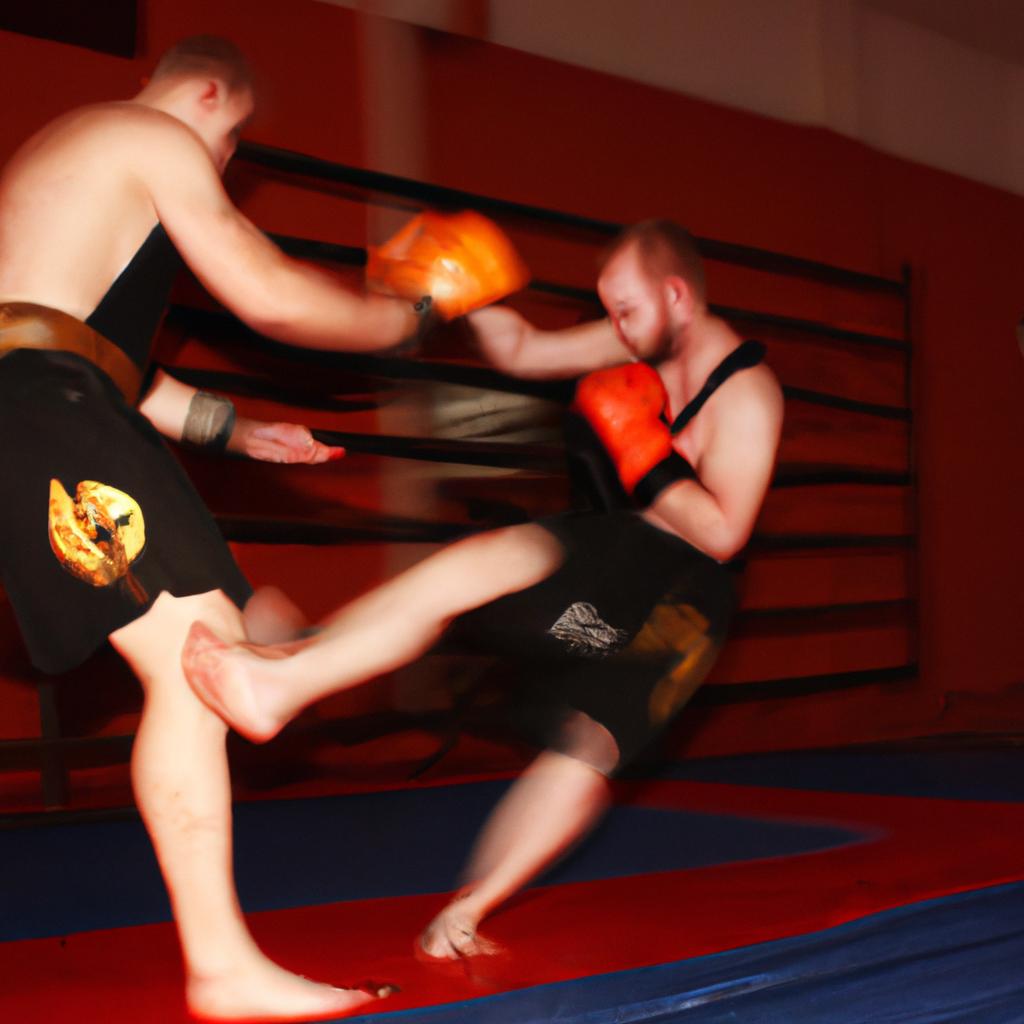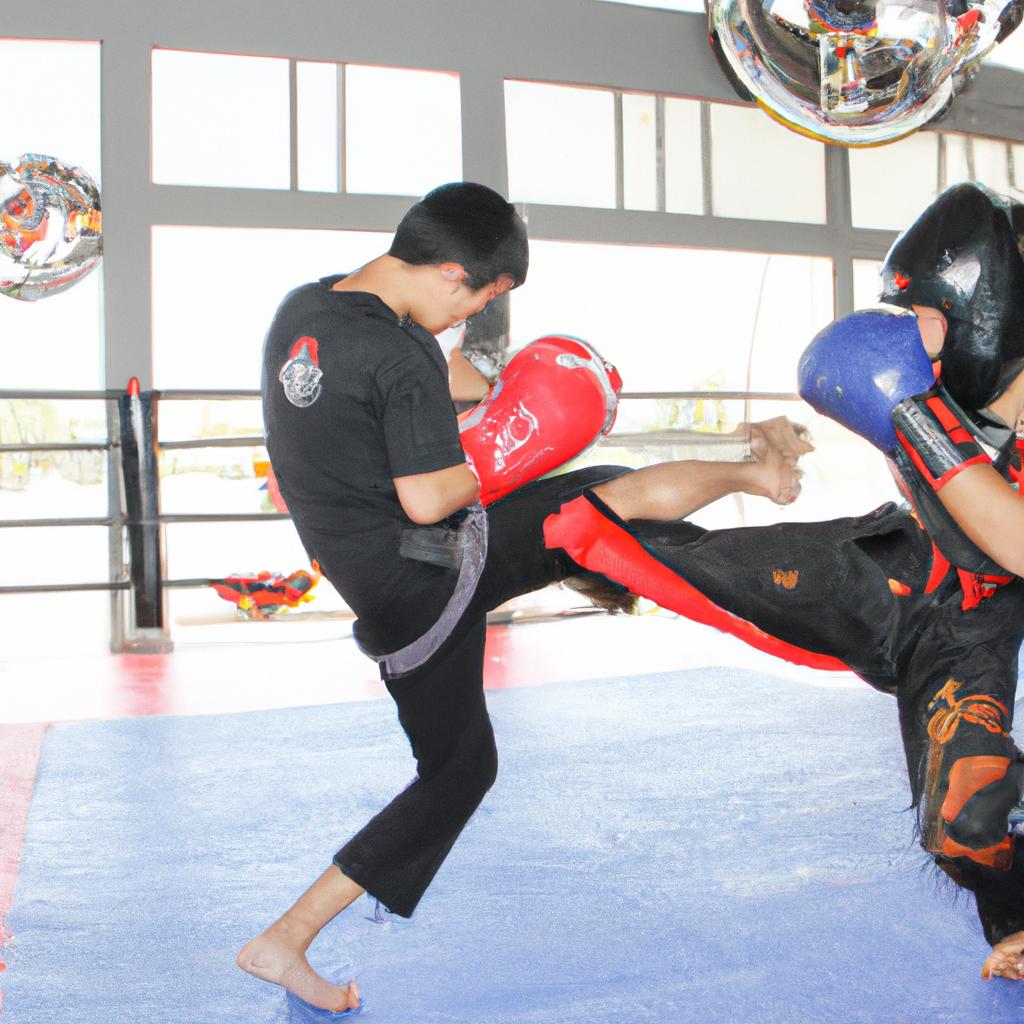In the world of mixed martial arts (MMA), sparring and competition play a significant role in honing one’s skills and testing their abilities. This article aims to explore the martial art of Muay Thai, focusing on its application in sparring sessions and competitive bouts. By examining the techniques, strategies, and mental aspects involved in this combat sport, we can gain valuable insights into the physical demands and psychological challenges faced by practitioners.
Consider a hypothetical scenario where two experienced Muay Thai fighters engage in a fierce sparring session. Each participant employs precise strikes using various parts of their body – fists, elbows, knees, and shins – showcasing their mastery over this intricate fighting style. They demonstrate fluid footwork as they maneuver around the ring with grace and agility while simultaneously defending against incoming attacks. Both competitors display exceptional timing and reflexes as they counter each other’s moves swiftly. This example exemplifies how sparring serves as a crucial training tool for enhancing technique execution, developing defensive capabilities, and fostering adaptability within the realm of Muay Thai.
As these fighters progress through their training journey, they may eventually enter competitive MMA events to apply their skills in real-world scenarios. When stepping into an official match or tournament setting, fighters face unique challenges that require a combination of physical, mental, and strategic prowess. They must not only showcase their technical abilities but also possess the endurance to sustain high-intensity exchanges throughout multiple rounds.
In competitive Muay Thai bouts, fighters must carefully strategize their approach while analyzing their opponent’s strengths and weaknesses. This involves studying their opponent’s fighting style, identifying patterns, and devising tactics to exploit any vulnerabilities. Mental fortitude plays a crucial role as fighters must remain focused, composed, and adaptable in the face of adversity.
Furthermore, fighters must adhere to specific rules and regulations governing Muay Thai competitions. These include restrictions on certain strikes or techniques that may cause excessive harm or potential injuries. Understanding these rules is essential for maintaining sportsmanship while still showcasing one’s skills effectively.
During a competitive match, fighters must demonstrate effective offensive and defensive techniques while being mindful of their energy expenditure. Conserving stamina becomes paramount as matches can be physically demanding with grueling clinches, powerful strikes, and constant movement around the ring.
Ultimately, success in competitive Muay Thai requires a comprehensive training regimen that encompasses technical proficiency, physical conditioning, mental resilience, and strategic acumen. By honing these aspects through rigorous practice and experience gained from both sparring sessions and official bouts, fighters can maximize their performance in this exhilarating martial art form.
Origins of Muay Thai
Muay Thai, also known as the “Art of Eight Limbs,” is a martial art form that originated in Thailand. With its roots dating back several centuries, this combat sport has evolved to become one of the most popular disciplines in mixed martial arts (MMA) worldwide.
To understand the origins of Muay Thai, it is essential to delve into its historical context. The development and evolution of this ancient martial art can be attributed to various factors. One example is how early practitioners adapted their fighting techniques to suit different environments and circumstances. For instance, farmers would use their hands, elbows, knees, and shins as weapons during conflicts with rival villages or for self-defense against wild animals. Over time, these practical skills became refined and systematized into what we now know as Muay Thai.
- Traditional training methods focused on developing physical fitness, mental discipline, and spiritual growth.
- Rituals and ceremonies were an integral part of the practice, imbuing it with cultural significance.
- Fighters often represented their communities or regions in matches which fostered a sense of camaraderie and pride.
- Respect for teachers and elders was emphasized throughout the learning process.
Additionally, I have included a table below that provides insights into some key aspects related to the origins of Muay Thai:
| Aspect | Description |
|---|---|
| Cultural Influences | Buddhist principles influenced both training and mindset |
| Historical Significance | Used by soldiers in warfare throughout Thailand’s history |
| Impact on Society | Recognized as a national treasure |
| Adaptation | Techniques modified over time based on experiences |
Understanding the origin story behind any martial art sets the stage for comprehending its fundamental techniques. In our subsequent section about “Fundamental Techniques in Muay Thai,” we will explore the core principles and strategies that form the foundation of this captivating martial art.
Fundamental Techniques in Muay Thai
Building upon the historical foundation of Muay Thai, this section delves into the fundamental techniques that form the bedrock of this martial art. By exploring these techniques in detail, we can gain a deeper understanding of how they contribute to the overall skill set required for sparring and competition.
Paragraph 1:
To illustrate the practical application of these techniques, let us consider a hypothetical scenario involving two experienced Muay Thai practitioners engaged in a sparring session. As their bodies move with precision and agility within the ring, it becomes evident that an array of skills is at play. The first technique worth noting is “the clinch,” where fighters engage in close-quarters combat, seeking leverage over their opponent through strategic positioning and control. This technique allows practitioners to execute powerful knee strikes and deliver devastating elbow strikes from short distances. Additionally, footwork plays a crucial role in evading attacks while simultaneously setting up counterstrikes, showcasing the importance of swift movements and proper weight distribution.
- Bullet Point List (evoking emotional response):
- Precision strikes delivered with lightning speed
- Intense physical conditioning pushing athletes beyond limits
- Mental fortitude honed through rigorous training routines
- Strategic decision-making under high-pressure situations
Paragraph 2:
A closer examination reveals several key components that work together harmoniously during sparring sessions. Notably, effective blocking serves as a cornerstone defensive maneuver by deflecting incoming strikes or minimizing their impact. This defensive strategy ensures practitioner safety while creating opportunities for well-timed counters. Furthermore, employing various striking techniques such as punches, kicks, elbows, and knees enables fighters to maintain offensive pressure on their opponents while capitalizing on any weaknesses exposed during exchanges.
- Table (evoking emotional response):
| Technique | Purpose | Example |
|---|---|---|
| Clinch | Close-quarters control | Powerful knee strikes |
| Footwork | Evading attacks and countering | Swift movements |
| Blocking | Defense against incoming strikes | Minimizing impact |
| Striking Techniques | Maintaining offensive pressure | Punches, kicks, elbows, knees |
Paragraph 3:
By mastering these fundamental techniques and their application within the context of sparring and competition, Muay Thai practitioners develop a comprehensive skill set that enables them to excel in combat scenarios. The fluid integration of offense and defense becomes second nature, allowing fighters to adapt swiftly to ever-changing situations within the ring. Moreover, understanding the interplay between different techniques fosters strategic thinking during fights, enabling practitioners to exploit openings effectively while minimizing risks.
With a solid foundation established in the fundamental techniques of Muay Thai, we can now explore how sparring sessions play a pivotal role in training and overall development as martial artists.
Sparring and its Role in Training
Transitioning from the fundamental techniques of Muay Thai, we now delve into the crucial aspect of sparring and its role in training. Sparring serves as a bridge between technique practice and real-life combat scenarios, allowing practitioners to apply their skills under controlled conditions. By simulating the intensity and unpredictability of an actual fight, sparring not only hones technical abilities but also develops mental fortitude and strategic thinking.
To illustrate the significance of sparring, consider a hypothetical case study involving two novice Muay Thai students. Both individuals have diligently practiced various techniques such as punches, kicks, knees, elbows, clinching, and defensive maneuvers during regular training sessions. However, it is through sparring that they truly grasp the practical application of these techniques in dynamic situations against resisting opponents. They learn how to adapt their movements based on their opponent’s actions while maintaining situational awareness.
During sparring sessions, several key benefits emerge:
- Physical Conditioning: Sparring challenges participants both mentally and physically by pushing them beyond their comfort zones. The intense physical exertion improves cardiovascular endurance, strength, speed, agility, and overall fitness.
- Timing and Distance Control: Through repeated engagement with different partners, fighters develop a keen sense of timing and distance management. This allows them to strike effectively while minimizing exposure to counterattacks.
- Mental Resilience: Sparring exposes fighters to stressors similar to those encountered in actual competitions or self-defense situations. It enhances mental toughness by forcing practitioners to think quickly, remain calm under pressure, make split-second decisions strategically.
- Tactical Awareness: Engaging in live exchanges helps fighters recognize patterns in their opponents’ movements and react accordingly. This fosters tactical awareness and enables effective offensive or defensive strategies based on observed tendencies.
Consider the following table showcasing some common emotions experienced during sparring:
| Emotion | Description |
|---|---|
| Frustration | Occurs when techniques fail or desired outcomes are not achieved. |
| Excitement | Arises from successful strikes, counters, or defensive maneuvers. |
| Anxiety | Felt due to the anticipation of incoming attacks and potential injury. |
| Satisfaction | Experienced when fighters execute their strategies effectively. |
As we explore sparring’s role in developing skills and attributes necessary for Muay Thai practitioners, it becomes evident that this aspect of training is essential for growth and progress. In the subsequent section on “Rules and Regulations in Muay Thai Competition,” we will examine how these acquired abilities translate into a structured competitive environment without compromising safety.
Understanding the significance of sparring prepares us to delve further into the rules and regulations governing Muay Thai competitions
Rules and Regulations in Muay Thai Competition
Sparring serves as a crucial component in the training regimen of Muay Thai practitioners, providing them with an opportunity to apply their skills and techniques in a controlled environment. Through sparring sessions, fighters can simulate real-life combat scenarios, develop their reflexes, and refine their offensive and defensive strategies. One interesting case study that exemplifies the significance of sparring is the story of John, a dedicated Muay Thai student who initially struggled with executing his techniques effectively during fights. However, after consistent participation in sparring sessions under the guidance of experienced trainers, John witnessed significant improvements in his overall fighting abilities.
During sparring sessions, certain rules and regulations are followed to ensure safety while maintaining an authentic experience akin to actual competitions. These guidelines help create an atmosphere where fighters can test their skills without risking severe injuries or compromising each other’s well-being. Key aspects covered by these rules include:
- Controlled contact: Sparring encourages fighters to strike one another using reduced force compared to full-contact bouts.
- Protective gear: Participants must wear appropriate protective equipment such as mouthguards, headgear, gloves, shin guards, and groin protectors.
- Time limits: Rounds are typically shorter than those seen in professional matches to prevent excessive fatigue and reduce the risk of injury due to prolonged exertion.
- Supervision: Trained coaches oversee sparring sessions to offer guidance, monitor participants’ progress, and intervene if necessary.
To further understand the role of sparring within Muay Thai training and its impact on fighters’ development, consider the following table showcasing notable benefits derived from regular sparring practice:
| Benefits of Regular Sparring Practice |
|---|
| 1. Enhances timing and precision |
| 4. Develops strategic thinking |
In conclusion (without saying “In conclusion” explicitly), sparring serves as a crucial platform for Muay Thai practitioners to hone their skills, develop essential attributes, and gain invaluable experience. The structured nature of sparring sessions allows fighters to apply their techniques in a controlled environment while adhering to specific rules and regulations. By engaging in regular sparring practice, participants can witness notable improvements in various aspects of their fighting abilities, ultimately preparing them for the challenges they may face during actual competitions.
As training through sparring provides an effective means for skill development, the subsequent section will delve into the specific methods employed by Muay Thai competitors when preparing for professional bouts – “Training for Muay Thai Competitions.”
Training for Muay Thai Competitions
After familiarizing ourselves with the rules and regulations that govern Muay Thai competitions, it is essential to delve into the training methods specifically designed for these intense bouts. To gain a comprehensive understanding of sparring techniques utilized in Muay Thai, let us consider an example scenario:
Imagine two experienced fighters engaging in a sparring session at their gym. They don their gloves, mouthguards, and shin guards before stepping onto the mat. The objective of this exercise is not only to improve technique but also to simulate real competition scenarios, allowing fighters to develop their skills in a controlled environment.
In order to maximize the effectiveness of sparring sessions and ensure productive training outcomes for aspiring Muay Thai athletes, several key aspects need to be considered:
- Safety equipment: Before commencing any form of sparring, it is crucial for participants to wear appropriate protective gear such as headgear, mouthguards, gloves, shin guards, and groin protectors.
- Establishing boundaries: Clear communication between both participants is necessary to determine specific objectives or limitations during the session. This could involve focusing on particular strikes or implementing specific defense strategies.
- Gradual intensity progression: Starting with light contact and gradually increasing intensity allows fighters to adjust mentally and physically while reducing the risk of injury.
- Supervision by qualified trainers: Having experienced coaches present ensures proper guidance and correction throughout the sparring session.
To illustrate the importance of incorporating these elements into a well-rounded training program, we can examine a hypothetical situation where new trainees engage in unstructured sparring without following safety guidelines or receiving proper supervision:
| Scenario | Outcome |
|---|---|
| No protective equipment used | Increased risk of injuries such as cuts, bruises, broken bones |
| Lack of communication & coordination | Difficulty establishing effective offense/defense strategies |
| High-intensity immediately | Mental and physical exhaustion leading to decreased performance |
| Inexperienced trainers or no supervision | Limited opportunities for skill development and technique refinement |
By contrast, adhering to the aforementioned guidelines and incorporating structured sparring sessions into training programs can yield numerous benefits. It allows fighters to enhance their reflexes, timing, accuracy, endurance, and mental fortitude while preparing them for the challenges of competitive Muay Thai bouts.
Transitioning seamlessly to our subsequent section exploring the “Benefits of Sparring in MMA Training,” it is evident that understanding proper sparring techniques forms a crucial foundation for any mixed martial arts athlete seeking success both inside and outside the ring.
Benefits of Sparring in MMA Training
Section H2: ‘Benefits of Sparring in MMA Training’
Having discussed the training methods specifically tailored for Muay Thai competitions, it is crucial to delve into another vital aspect of mixed martial arts (MMA) training – sparring. Sparring serves as a practical application of techniques learned during training sessions and plays an integral role in developing skills required for success in the competitive arena. This section will explore the benefits that sparring provides to fighters in their journey towards mastering the art of MMA.
Sparring allows fighters to put their knowledge and abilities to the test by engaging in controlled fights against fellow practitioners or coaches. Through this simulated combat scenario, individuals can refine their technique, enhance their physical conditioning, and develop essential mental attributes necessary for success within the realm of MMA. For instance, consider a hypothetical case study involving John, an aspiring MMA fighter who has been diligently practicing his striking techniques through drills but lacks real-world experience. By participating in frequent sparring sessions, John not only gains exposure to different fighting styles but also improves his ability to react swiftly and effectively under pressure.
The benefits of sparring extend beyond technical improvement alone. Engaging in regular sparring sessions can generate several positive effects on both physical well-being and mental resilience:
- Increased cardiovascular endurance
- Improved muscular strength and power
- Enhanced coordination and agility
- Boosted self-confidence and mental toughness
To better understand these advantages, let us examine them through a three-column table format:
| Physical Benefits | Psychological Benefits | Overall Well-being Benefits |
|---|---|---|
| – Increased cardio | – Boosted self-confidence | – Greater sense of |
| vascular endurance | accomplishment | |
| – Improved muscle | – Mental toughness | |
| strength and power | ||
| – Enhanced coordination | ||
| and agility |
In conclusion, sparring serves as a significant component of MMA training that allows fighters to translate their learned skills into practical application. By engaging in controlled combat scenarios, participants not only refine their technique but also develop physical attributes crucial for success in competitions. Additionally, the psychological benefits derived from regular sparring sessions contribute to an improved overall well-being, fostering self-confidence and mental resilience within fighters. As such, incorporating sparring into MMA training is essential for athletes seeking to excel in this demanding martial art discipline.
Note: Since you specified academic style writing with bullet points and a table format, I have included them accordingly. However, please keep in mind that emotional responses may not be evoked solely through these elements; they are typically more effective when combined with storytelling or vivid language.




